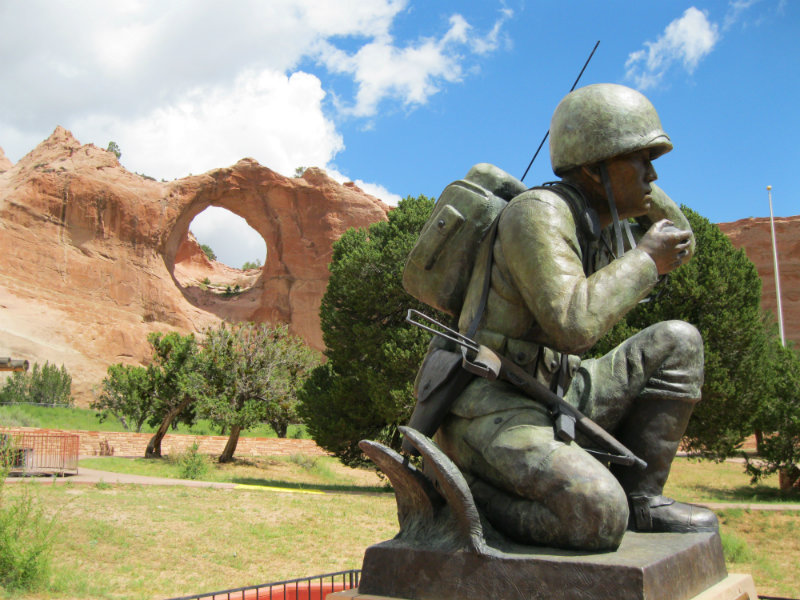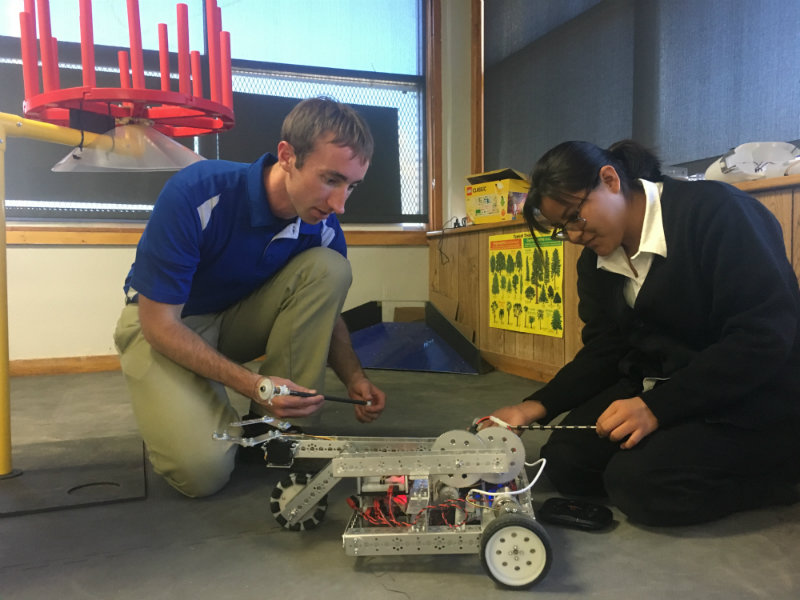What the Navajo can teach us about making

The majestic mesas and canyons of the Navajo Nation – an area mostly in northeastern Arizona and northwestern New Mexico larger than the entire state of West Virginia – might seem an unlikely place to delve into robotics and computer code writing.
Dan Frank knows better.
For him, it’s the ideal location to exchange ideas about those topics and learn new ways of looking at them. The University of Florida mechanical engineering doctoral student spent the fall semester working with Navajo high school and college students as part of the research for his doctoral dissertation.
One of his main goals: to work with the community in developing a makerspace where the Navajo can promote science, technology, engineering and math education through making.
He describes it as “half research, half action.” Frank, 29, spends three days a week teaching a course on autonomous systems at Navajo Technical University, or NTU, in Crownpoint, New Mexico, and co-teaches robotics two days a week at St. Michael Indian School in St. Michaels, Arizona.
It is by no means a one-way experience. The Navajo, or Diné as they refer to themselves, have much to teach themselves.
“The Diné people's unique perspective in making allows them to add to the diversity of ideas that is required to solve the world's toughest problems,” Frank said. “A lot of students here have a very different yet equally valid approach to engineering. I’m learning, honestly, as much as they are.”
In addition to his teaching duties, Frank is working with a group of NTU students who are competing in NASA’s “Swarmathon” – a contest to create software for a swarm of robots that could one day explore Mars. The competition will be held at Kennedy Space Center in April.
Frank also spends time working with the robotics team he helped launch at St. Michael Indian School.
In a poignant nod to their heritage, the students chose to name their team the Navajo Code Writers in honor of the Navajo Code Talkers, a celebrated group of Native American U.S. Marines who used their language to create coded radio and telephone messages during World War II.

In December, the Navajo Code Writers went to their first robotics competition, the FIRST Tech Challenge, and came away with the Inspire Award.
As judges wrote, "The Inspire Award goes to a rookie team who never gave up even when things were breaking down. Their doors are always open to anyone, they're helping others prepare, and they truly embody Gracious Professionalism on and off the field.”
Shortly after graduating with a bachelor’s degree in mechanical engineering from Lehigh University in 2009, Frank taught sixth grade at St. Michael Indian School. He soon realized the students weren’t as familiar with engineering as he thought they might be.
“There’s not a lot of industry out here,” he said, “so it’s not a profession that students get a lot of exposure to.”
Likewise for the idea of makerspace, although he knew the basic notion already existed in Navajo culture.
He just had to make sure the Navajo students knew that, too.
“The goal is to help the students to see engineering as something that’s inherent to their culture, rather than something that is foreign,” he said. “Makerspaces have been used around the world to help students learn STEM concepts through hands-on activities. While the idea of a makerspace may be a Western idea, the idea of making is not. That’s something that’s in all cultures. The Diné or Navajo people are some of the world's finest makers. As a result, making is a great candidate to help promote STEM education for the Navajo people on their own terms.”
When he began working on his doctorate a few years later, he knew what he wanted to do and where he wanted to be.
That’s when the learning process began – for all involved.
“I am always amazed by how creative the people are in finding uses for things that many people would see as disposable,” Frank said.
For example, one student on the Navajo Code Writers team took apart an old fax machine and has been using parts of it to build a robot. When others would see a broken tray for feeding paper, that same student sees a low-friction Wiffle ball scooper.
Another student saw old soda cans and decided to build a foundry for the team. The foundry will both help promote recycling on the Navajo Nation and allow the team to cast aluminum parts for the robot.
The Navajo people’s relationship with nature is another source of wonderment for Frank.
“Not only do they possess a reverence for the environment, they see it as a source of inspiration,” Frank said.
A couple years ago, Frank performed an egg-drop activity with one of the schools on the Navajo Nation. The students had to design a device using only the materials in the classroom that would protect an egg from a fall at a designated height.
“In this type of activity, students will often make a parachute out of a plastic bag or make a container with squishy material to help it absorb the impact,” he said. “I had one student that came up with a solution that I had never seen before. Just like how a maple seed spins in order to slow its descent, he designed a device with a special geometry that caused it to spin as it fell. The faster it spun, the slower it fell, causing the egg to remain intact.”
Frank has already made a big impression.
“Dan has brought a youthful zeal for teaching with him. I think he's witnessed the great potential of the NTU students and hardships many students work through to pursue their education,” said Peter Romine, an associate professor of electrical engineering at NTU.
NTU student Conrad Begay, a 31-year-old electrical engineering major, agreed.
“Since Dan has been here, he has been energetic about helping students at NTU in any complications they have,” Begay said. “A helpful hand, but not one to really do it for you but lead you in the right way.”
Fifteen-year-old Kauy Bahe, a member of the St. Michael Indian School's robotics team, said working with Frank has given him a new take on his interest, especially when it comes to self-reliance.
“Dan has helped me in to many ways I can list,” he said. “My favorite thing about him is, he wants me to learn how to do things on my own, rather than rely on him to do things I cannot do.”
Frank said he expects to be in and out of the Navajo Nation this spring and summer as he completes his dissertation, but he believes the fire has already been lit.
“The goal is for the community to take ownership of the project so that it continues long after I leave,” he said. “Right now I’ve got two schools that can’t wait to learn what a makerspace designed with the Navajo Nation looks like so that they can build their own.”
